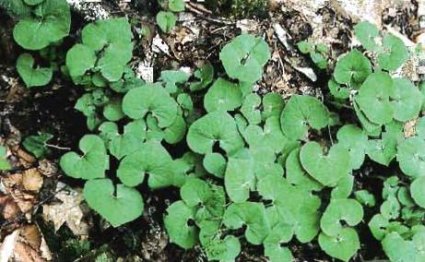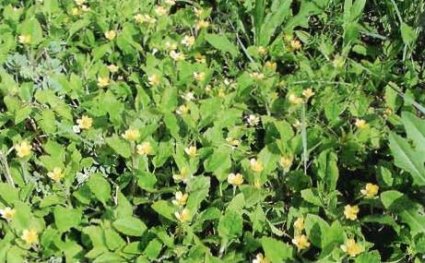
This is the third of a series of posts that will cover the "Top 100" forest garden plants taken from volume 1 of the Edible Forest Gardens books. In this post we finish our list of prostrate herbs.

WILD GINGER (Asarum SPP.)
Wild Ginger - Asarum canadense
Hardiness zone 3, part to full shade, running mat former, 4-8 in. x indefinitely spreading, ground cover, edible root (image above)
Shuttleworth's Wild Ginger — Asarum shuttleworthii
Hardiness zone 6, part to full shade, evergreen clumping mat former, 4-8 in. x 14 in., ground cover
Wild ginger is one of our best native ground covers. These dense, low-growing species spread indefinitely. They make lovely ornamentals, especially evergreen species such as Shuttleworth's wild ginger. The roots of some species, including wild ginger, supposedly substitute for cultivated ginger. In our experience, the flavor is not nearly as pleasant as that of ginger—it has a bit of a medicinal flavor. Nevertheless, wild gingers are an outstanding choice for a native shade-loving ground cover.
Green and Gold - Chrysogonum virginianum
Hardiness zone 4, full sun to part shade, evergreen clumping mat former, 3-6 in. x 18in., specialist nectary, ground cover (image below)
Also known as golden star, this is another fantastic native ground cover. While not fast growing, this slow and steady mat former is a reliable low-maintenance species for sun to partial shade. It forms low, dense evergreen mats that are covered by beautiful yellow daisylike flowers in spring and early summer. Goldenstar flowers in the early part of the year—the crucial period when the forest garden needs beneficial insects but few other specialist nectaries are available. This trait, combined with green and gold's excellence as a ground cover, makes it a great choice for forest gardens.
STRAWBERRIES (Fragaria SPP.)
Garden Strawberry - Fragaria X ananassa
Hardiness zone 3, full sun, evergreen running, 6-12 in. x indefinitely spreading, edible fruit, ground cover
Beach Strawberry - Fragaria chiloensis
Hardiness zone 7, full sun, evergreen running, 6 in. x indefinitely spreading, edible fruit, ground cover
Musk Strawberry - Fragaria moschata
Hardiness zone 5, full sun to part shade, evergreen running, 6-12 in. x indefinitely spreading, edible fruit, ground cover
Alpine Strawberry - Fragaria vesca alpina
Hardiness zone 3, full sun to part shade, evergreen clumping, 10 in. x 10 in., edible fruit
Wild Strawberry - Fragaria virginiana
Hardiness zone 4, full sun to part shade, evergreen running, 4-12 in. x indefinitely spreading, edible fruit, ground cover
As a group, strawberries generally make excellent edibles and only moderate ground covers. They are well suited to sunny pockets of production or to being interwoven with clumping species in polycultures. Most spread indefinitely as runners and are self-pollinating. A few varieties do require a pollinator.
Beach strawberry is native from California to Chile on the Pacific coast. Fruit quality is allegedly good but not great. Unlike most strawberries, it makes a dense, evergreen ground cover. Unfortunately, it is not very hardy. Musk strawberry is an underutilized species that, while not very productive, bears delicious fruit said to taste of raspberry and pineapple. Alpine strawberry is unusual in that it forms a single clump and does not spread. It is a great candidate for the edges of garden pathways because it ripens just a few small fruit at a time, but does so throughout the growing season. Thus if you walk by every day you can make the most of what it has to offer—and there is more strawberry flavor packed into one of these tiny fruits than in any number of enormous store-bought hybrids! Wild strawberry, our native wild species, bears small, sweet fruits. It is not much of a ground cover, but it intermingles well with grasses and wildflowers in meadows here in New England. We could use it similarly in the forest garden. Garden strawberry is the common cultivated form, a hybrid of several of the above species. You can't beat it for productivity, and many cultivars have excellent flavor. This is a perfect species for pockets of production, but it might want to have its patch rotated every few years for disease prevention. Strawberry-rhubarb pie is sure to be a favorite product of the forest garden!
Galax - Galax urceolata
Hardiness zone 4, part to full shade, evergreen running, 6-12 in. x indefinitely spreading, ground cover
This native evergreen ground cover is an excellent choice for forest gardens with some shade. It spreads, but not overly vigorously, forming a dense colony of tight clumps. Galax is another underutilized native deserving of attention. We are happy it is becoming more available as an ornamental.



No comments:
Post a Comment